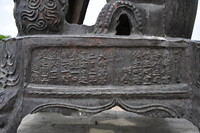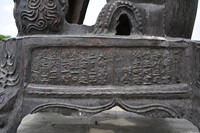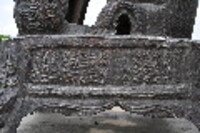| dc.description | Chinese guardian lion (shishi), in temple context (foshi, Buddha's lion); inscriptions on base of bronze lion; Also called the Mu ta (Timber Pagoda) or Fogong si. One of the extant buildings of the Liao dynasty, a Northern Chinese dynastic period dating from 907 to 1125; it was founded by the proto-Mongolian and nomadic Khitan people. Liao architecture displays Tang influence and an adherence to Buddhism. The pagoda is dedicated to Shakyamuni Buddha. The pagoda stands on a 4 m (13 ft) tall stone platform, has a 10 m (33 ft) tall steeple, and reaches a total height of 67.31 m (220.83 ft) tall; it is the oldest existent fully wooden pagoda still standing in China. The wide, octagonal, five-story (exterior) structure is somewhat squat. The compact bracket system supporting the steeply sloping and projecting eaves is fairly sophisticated, and flying rafters are employed throughout. The structure is unique: its six layers of exterior eaves conceal its interior construction: five interior colonnaded floors and four perimeter galleries, topped by a roof level. Moreover, 56 different bracketing formations have been identified, many of which correspond to illustrations in the Yingzao fashi of 50 years later. Source: Grove Art Online; http://www.oxfordartonline.com/ (accessed 7/31/2012) | en_US |


